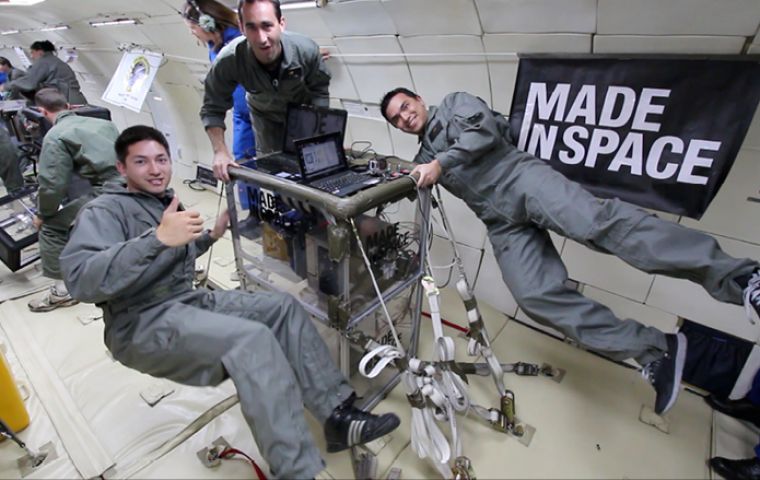MercoPress. South Atlantic News Agency
Nasa plans to launch 3D printer to help astronauts manufacture spare parts
 The agency is also experimenting with 3D printing small satellites that could be launched from the International Space Station
The agency is also experimenting with 3D printing small satellites that could be launched from the International Space Station The United States space agency Nasa is planning to launch a 3D printer into space next year to help astronauts manufacture spare parts and tools in zero gravity. It will be the first time a 3D printer has been used in space and could help reduce the costs of future missions.
The device will have to withstand lift-off vibrations and operate safely in an enclosed space station environment. Nasa has chosen technology start-up Made in Space to make the microwave oven-sized printer.
“Imagine an astronaut needing to make a life-or-death repair on the International Space Station,” said Aaron Kemmer, the company's chief executive.
“Rather than hoping that the necessary parts and tools are on the station already, what if the parts could be 3D printed when they needed them?”
In 1970, Apollo 13 astronauts had to cobble together a home-made carbon dioxide filter using a plastic bag, a manual cover and gaffer tape.
A 3D printer might have solved the problem in minutes.
”If you want to be adaptable, you have to be able to design and manufacture on the fly, and that's where 3D printing in space comes in,'' said Dave Korsmeyer, director of engineering at Nasa's Ames Research Centre.
Nasa is also experimenting with 3D printing small satellites that could be launched from the International Space Station and then transmit data to earth.
Additive manufacturing, as 3D printing is also known, builds up objects layer by layer, commonly using polymer materials. But laser-melted titanium and nickel-chromium powders are now being used to build much stronger components.
In August, Nasa successfully tested a metal 3D printed rocket component as part of its drive to reduce the costs of space exploration.




Top Comments
Disclaimer & comment rules-

-

-

Read all commentsI bet the bottles of “ink” are expensive though.
Oct 02nd, 2013 - 04:59 pm 0@ChrisR
Oct 03rd, 2013 - 11:34 am 0The materials are not expensive at all. ABSLike Printing Grade filament cost range from U$s38 to U$s 50 2 pounds for FDM (Fused Deposition Modeling).
But this works for gravity so cannot be used in space without gravity as this article says.
Then you have SLA (stereolithography) that use DLP (digital light processing) that solidified micronised photosensitive powder resins or liquid resins.
Again will be tough to get this element not floating in 0 gravity environment. What do you think?
Then you have to have into account that while FDM can reproduce a model with 90% of durability and characteristics of an injected plastic part. SLA needs a secondary process to cure the model with additives to harden the model and to archive certain resistance to be a functional model.
So nothing new this have been around since long time ago in fact you can have your own SLA printer at home for less than U$s 5000 or your FDM printer for less than U$s2000 in Argentina.
SLA
http://www.youtube.com/watch?v=gU4KrQBTQzI
FDM
http://www.youtube.com/watch?v=gU4KrQBTQzI
SYL mate
http://www.maplin.co.uk/3d-printer-kit-velleman-k8200-783902
Oct 03rd, 2013 - 12:35 pm 0.....or here for £699.99
.......cartridge cost £29.99
Commenting for this story is now closed.
If you have a Facebook account, become a fan and comment on our Facebook Page!